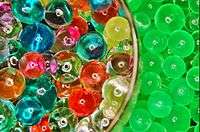Sodium polyacrylate
 | |
 | |
| Names | |
|---|---|
| IUPAC name
sodium prop-2-enoate | |
| Identifiers | |
| 9003-04-7 | |
| ChemSpider | 22446 |
| Jmol interactive 3D | Image |
| PubChem | 4068533 |
| |
| |
| Properties | |
| (C3H3NaO2)n | |
| Molar mass | Variable |
| Density | 1.22 g/cm3 |
| Hazards | |
| Safety data sheet | MSDS |
| Except where otherwise noted, data are given for materials in their standard state (at 25 °C [77 °F], 100 kPa). | |
| | |
| Infobox references | |
Sodium polyacrylate, also known as waterlock, is a sodium salt of polyacrylic acid with the chemical formula [-CH2-CH(CO2Na)-]n and broad application in consumer products. It has the ability to absorb as much as 200 to 300 times its mass in water. Sodium polyacrylate is an anionic polyelectrolyte with negatively charged carboxylic groups in the main chain. While sodium neutralized polyacrylic acids are the most common form used in industry, there are also other salts available including potassium, lithium and ammonium.
Applications
Sodium polyacrylate and other derivatives of polyacrylic acid have a wide variety of commercial and industrial uses that include:
- Sequestering agents in detergents. By binding hard water elements such as calcium and magnesium, the surfactants in detergents work more efficiently.
- Thickening agents
- Coatings
- Artificial snow
- Laundry detergent
- Disposable diapers
- Potted plants
- Bath time recreational gel (such as Gellibaff or Squishybaff)
- Super absorbent polymers. These cross-linked acrylic polymers are referred to as "Super Absorbents" and "Water Crystals", and are used in diapers.[1] Copolymer versions are used in agriculture and other specialty absorbent applications. The origins of super absorbent polymer chemistry trace back to the early 1960s when the U.S. Department of Agriculture developed the first super absorbent polymer materials.[2] This chemical is featured in the Maximum Absorbency Garment used by NASA.
- Personal lubricant
See also
- Polyacrylamide can be co-polymerized with acrylic acid and other monomers. In cross-linked form, these blended co-polymers can yield specialty superabsorbent polymers.
- Polyacrylic acid
References
- ↑ "What are the components of a typical disposable diaper?". Retrieved Jan 8, 2015.
- ↑ History of Super Absorbent Polymer Chemistry, M2 Polymer Technologies, Inc. Accessed 29 April 2009.
This article is issued from Wikipedia - version of the Thursday, January 21, 2016. The text is available under the Creative Commons Attribution/Share Alike but additional terms may apply for the media files.